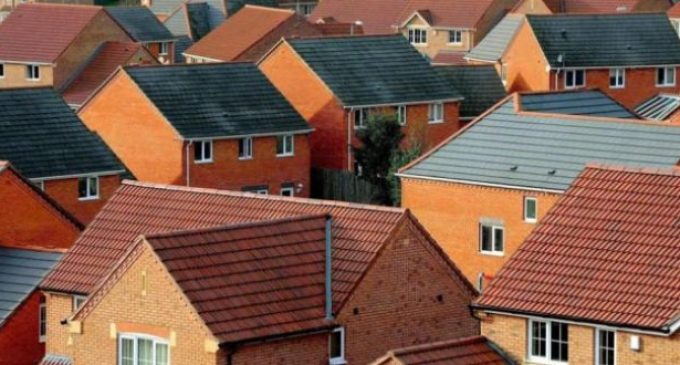125 local buildings under construction in Laois

According to a report in the Leinster Express, residential construction has increased by 36% year-on-year, according to the latest edition of GeoView published by GeoDirectory. A total of 5,966 buildings were classified as being under construction in the GeoDirectory database in June 2017, compared with the June 2016 figure of 4,375. Dublin continues to account for the bulk of new construction activity, at just under 25% of all buildings under construction.
There was a total of 125 buildings under construction in Laois.
The database found that there was a total of 1,967,698 residential dwellings across the country in June 2017.
By cross referencing data from the 2016 CSO Census of Population, the Department of Housing, Planning, Community and Local Government and the GeoDirectory Database, the GeoView report offers new, unique insights into the residential housing density, turnover and construction levels and the housing shortage across the country.
One of the reasons for the sharp increase in construction is the low number of vacant properties in the market. In the GeoView report, a property is considered vacant if it falls into one of the following groups:
The dwelling is vacant and ready to be inhabited, based on whether the property does or does not receive post;
The dwelling is vacant and requires a small amount of cosmetic/repair work to make it habitable; and
The dwelling is not a holiday home.
GeoDirectory report an estimated vacant stock of 96,243 (4.9% of the total stock) address points or dwellings in June 2017, while the 2016 Census reported a vacant stock of 183,312 (12.3%) dwellings, as of April 2016.
The 2016 Census enumerators, in identifying vacant dwellings, were instructed to look for signs that the dwelling was not occupied e.g. no furniture, no cars outside, junk mail accumulating or overgrown garden, and to find out from neighbours whether it was vacant or not. It was not sufficient to classify a dwelling as vacant after one or two visits.
Dublin (0.89% of the Dublin total stock) and the surrounding counties of Kildare (1.99%), Meath (3.35%), Wicklow (2.65%) and Louth (3.61%) had the lowest percentages of vacant units by county in the State.
The other end of the scale is dominated by counties in the west of Ireland, namely Leitrim (16.61%), Roscommon (13.88%) and Mayo (13.06%). 4.9% of properties in Laois were vacant.
Residential data from the Department of Housing, Planning, Community and Local Government showed that in the twelve months to March 2017, a total of 14,192 commencements were registered, with Dublin (5,317), Cork (1,568) and Meath (1,291) between them accounting for just under 60 per cent of the national total.
The gulf between the housing market in Dublin and the rest of the country can be seen clearly when the average national property price is examined.
The national average house price for the year was €250,188, an increase of almost €23,739 since last year. When Dublin is removed from the figures, the national average property price falls to €175,782.
The average residential property price in Dublin now stands at €404,911, this is €40,628 above the price this time last year.
This is well above the averages for the rest of the country with the next highest average price recorded in Wicklow (€316,057). Longford, where the property market has been one of the poorest performers recorded the lowest average price of €92,084.
The average property price in Laois was €171,813, an increase of €42,128 since the June 2016.
An analysis of dwellings per 1,000 of the population, shows a further example of the urban/rural divide that currently exists in Ireland. Counties on the west coast of Ireland recorded the greatest concentration of dwellings per 1,000 of the population, particularly Leitrim (552), which had the lowest average household size in the country (2.3 persons per household).
In contrast, Meath had only 353 dwellings per 1,000 of the population, while it had the largest average household size (3 persons per household).
The average national housing turnover rate in the twelve months to May 2017 was 2.22 per cent, with seven of the twenty-six counties recording turnover rates above this average.
The counties with the highest turnover rates were Westmeath (2.88%), Dublin (2.69%) and Kildare (2.55%).
Commenting on the findings, Dara Keogh, CEO, GeoDirectory said: “From this edition of GeoView, we have some very interesting findings.
“We can see that there has been a sharp increase in construction levels, 36% year-on-year. This however is focused on Dublin, where the property market is under severe pressure to keep up with demand. This pressure on the market is again evident when we look at vacancy rates.
“By evaluating how GeoDirectory defines a vacant property, we have reached a figure of 96,243 vacant address points; this is almost 50% lower than previously reported and we believe this is much closer to the true figure.”
Annette Hughes, Director of DKM Economic Consultants said: “As of June 2017, there were 1,967,698 residential dwellings across the Republic of Ireland. With 43,767 property transactions in the year there was a turnover rate of 2.22%; 90% of the properties transacted were second hand dwellings.
“This along with increasing property prices suggests that a substantial increase in construction activity is very much needed.”







